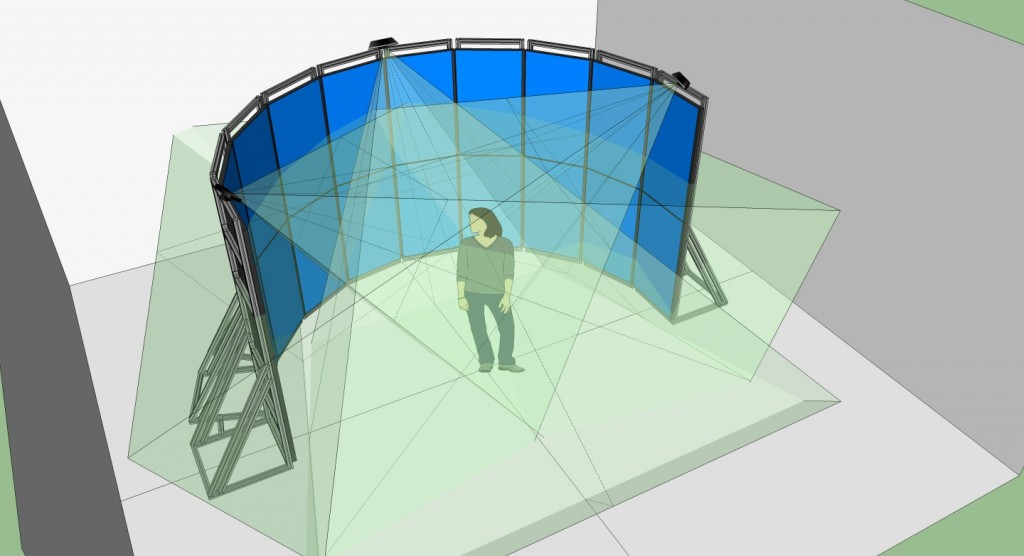DSCVR System in the School of Human Ecology
This page is an archive of the original proposal for the DSCVR system. A paper describing the design considerations, specifications, and lessons learned while building the system can be found in preprint form here
http://pages.cs.wisc.edu/~kponto/publications/dscvr.pdf
or in the Journal of Virtual Reality
DSCVR: designing a commodity hybrid virtual reality system, K Ponto, J Kohlmann, R Tredinnick, Virtual Reality, DOI 10.1007/s10055-014-0254-0.

Model of the completed DSCVR System
an example of the system in operation can be found here
Initial Proposal
We propose building a novel and immersive virtual reality display environment using consumer-grade displays and electronics. This project serves many purposes, the first of which is to provide a visualization space for Design Studies, Human Ecology, and serve members of the UW–Madison academic community interested in design inquiry.
We’ve chosen to name the project “DSCVR”, which stands for “Design Studies Commodity Virtual Reality”. This name reflects the system’s purpose as a tool, built from commercial- grade hardware, for exploring design within the context of VR.
We envision this system as a space for design review and experimentation. It focuses on the future of low-cost, high fidelity immersive display environments. It thereby enables new possibilities in consumer and behavior research within simulated environments.
The system allows us to approximate existing virtual reality systems, such as CAVEs, in a far more cost-effective manner. We view DSCVR and the C6 CAVE in the Wisconsin Institute for Discovery as complementary technologies, allowing us to explore the benefits and limitations of both. Here are some of the benefits of this new system.
- DSCVR features a higher resolution display system with more vibrant color and contrast— perfect for high fidelity fabric, textile, and texture rendering.
- Users wear light, inexpensive 3D glasses and no tracking equipment.
- The system’s LCDs and computers have a lower operating cost than a C6 CAVE.
- Building the system from consumer-grade components enables an immersive display environment at a tenth of a C6 CAVE’s cost.
- Having a second virtual reality system on campus allows us to experiment with telepresence and communication between multiple virtual reality environments.
Equipment
DSCVR uses a half-cylindrical arrangement of 20 thin-bezel, LED-backlit, passive 3-D, 1080p displays mounted on framing equipment. Network traffic will be managed with an internal router, so the system requires only one physical connection to the Internet and the rest of the SoHE building. It will use several Microsoft Kinect for Windows sensors for optical tracking. The system will also use a conventional Dolby 5.1 surround speaker system. Users will wear passive stereo 3-D glasses and minimal to no tracking equipment to interact with the system. Compared to a C6 CAVE. 10 computers with high-end gaming graphics cards drive the system, with one computer driving two displays each.
Applications in the Design Studies Department
DSCVR will enable entirely new ways of solving design challenges with physical and purely virtual structures. We can imagine a design student who takes an existing object, such as a chair, and brings it to DSCVR to alter and improve it. She digitizes the object with the aid of Kinect sensors and a rotating pedestal. She considers the digital copy in a virtual environment, such as an architecture student’s house model. Not only could she move herself and the object within the space, but she could use her hands to directly manipulate the virtual object, changing its size, colors, textures, and proportions. This is just one of myriad possibilities DSCVR will unlock, in which real and virtual objects would transition back and forth through multiple iterations.
The system is built entirely with consumer grade hardware. The system will go live in the Fall of 2013.
